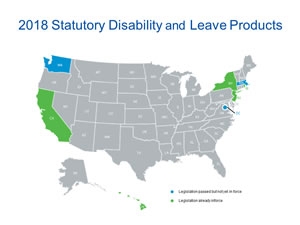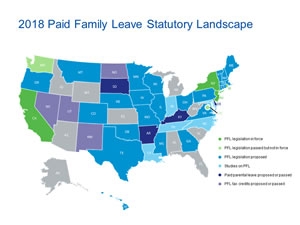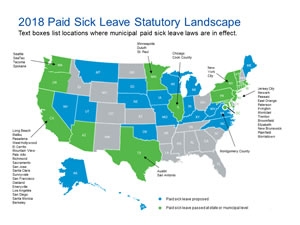Paid Leave Laws and Short Term Disability: Issues and Impacts

Have changes to paid leave laws made you rethink your strategy for Short Term Disability insurance?
That's what employers in some states are doing. Others are cautiously watching proposed legislation on the federal and state level.
Where should you start? Let’s begin with a quick review of what happened with paid leave laws in 2018.
State, Local and Federal Laws
In 2018, more than 40 percent of states introduced some type of paid leave law. Right now, the total number of laws that states have proposed, passed or already implemented is at 241 and counting.
While states seemed focused on paid family and medical leave, local governments appeared concerned with paid sick leave.
These thumbnails show just how much the paid leave landscape changed across the states in 2018.

(Click thumbnail to view full-size image.)

(Click thumbnail to view full-size image.)

(Click thumbnail to view full-size image.)
At the federal level, paid sick leave and paid family leave had some bipartisan support. Currently, there are three proposals for national legislation that would provide paid leave for employees. The Workflex in the 21st Century Act, the Family and Medical Insurance Leave Act and the Economic Security for New Parents Act each try to address distinct aspects of the issue.
Even the President is mentioning paid leave. His plan for a national paid parental leave program would give parents time off to bond with their children.
For a more detailed overview, check out our one-stop guide to what happened in 2018 and what's on the horizon for 2019.
What Does All This Mean for Short Term Disability?
The number of employers offering STD has dropped in some states. After California, New Jersey and Rhode Island began their statutory disability programs, the number of businesses that offered STD plans in those states decreased. Employers reasoned they were already paying into the state program, so keeping their own STD plan didn't make sense.
Voluntary STD plans that pay on top of state plans may increase. States are rolling out programs that replace most workers’ incomes at fairly generous levels. But states may be falling short for higher paid employees. In response, some employers are offering voluntary STD. The shift lets employees buy added protection for their income. Does this development signal what’s to come in Washington and Massachusetts? As the two states begin their programs, we'll likely see fewer small to mid-size companies offering STD plans. The change may lead to a rise in voluntary STD plans that are completely employee-funded.
Better paid leave benefits attract better job candidates. Large employers wanting to recruit top talent may offer more generous insurance than their state requires.
Single bucket paid time off may go back to the future. Right now, many employers use a single bucket of time for vacation, sick time and paid time off. But the slew of different leave laws might send them back to separating sick time from vacation time.1
New laws in Washington, Massachusetts and New York may stop state employers from requiring that employees use PTO for unpaid leave. Both Washington and Massachusetts are applying all Family and Medical Leave Act conditions to their Paid Family and Paid Medical Leave laws. With this added state paid benefit — that applies to all FMLA conditions — employers may not be able to require that employees use PTO when on FMLA in those states. So, employers may have to rethink their PTO strategies.
Are You Handling Your Own Paid Leave Administration?
Consider these critical factors:
- Your supervisors and administrators can be personally liable.
- Fear of employee lawsuits could increase pressure to approve federal or state mandated leaves that might not be covered if handled by an outside party.
- Possible lack of consistency across all your locations.
- You may lack the resources to stay up to date on new laws and changes.
- Intermittent leave is tough to manage and track.
What Should You Be Doing?
The key is to keep up with all the activity on paid leave. Watch for developments in your city and state, as well as the federal government. Then consider what it all means for your business — and for your HR team.
Watch This Space
The Standard is committed to partnering with employers across the country. We're here to help you anticipate and understand ever-evolving paid family leave regulations.
Subscribe to our RSS feed for Relatively Speaking, our PFL-focused blog, to catch all our updates.
Feeling social? Follow The Standard on Facebook, LinkedIn and Twitter with the hashtag #PaidFamilyLeave.
More About Legislative Activity








